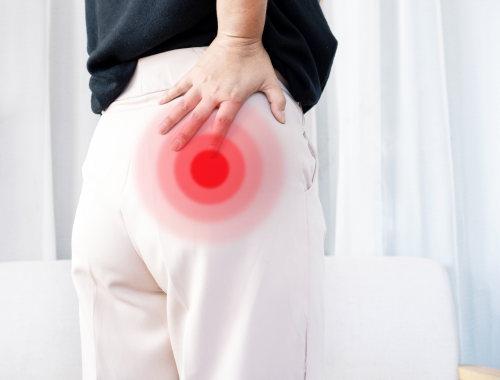Difference Between Piriformis Syndrome and Sciatica
Piriformis syndrome is the pain in the buttocks and along the course of the sciatic nerve that occurs when the piriformis muscle presses on the sciatic nerve. Sciatica is lumbar radiculopathy that causes lower back pain which radiates along the course of the sciatic nerve down to the thighs.

What is piriformis syndrome?
Definition:
Piriformis syndrome is the pain in the buttocks and along the course of the sciatic nerve that occurs when the piriformis muscle presses on the sciatic nerve.
Causes:
Causes of piriformis syndrome include inflammation of the piriformis muscle or its spasm or scarring. Rigorous exercise with weak piriformis muscles can lead to these issues. Other causes are trauma to the buttocks, damaged piriformis muscle after weightlifting, excessive sitting for long periods, and reduced physical activity causing a bulk of tight buttock muscles.
Symptoms:
Symptoms of piriformis syndrome are aching, shock-like, shooting, and numbing pain in the buttocks, thighs, and leg. Symptoms are aggravated by sitting, walking, and running.
Diagnosis:
Piriformis syndrome is diagnosed mainly on history and physical examination which involves stretching, rotating, and moving the buttocks and legs. Rarely radiologic investigations like CT scans and MRI scans are advised by healthcare professionals.
Treatment:
Treatment options for piriformis syndrome are resting, mild physical exercises, use of nonsteroidal anti-inflammatory drugs (NSAIDs), steroid injections, botulinum toxin injections, use of muscle relaxants, and muscle massage.

What is sciatica?
Definition:
Sciatica is a type of radiculopathy that causes lower back pain that radiates along the course of the sciatic nerve down to the thighs.
Causes:
Causes of sciatica include vertebral disc prolapse, spinal stenosis, osteoarthritis, spondylolisthesis, trauma to lumbar vertebrae, tumors involving the lumbar vertebrae, piriformis syndrome, and cauda equina syndrome.
Symptoms:
The symptoms of sciatica include lower back pain that exists in the buttocks and migrates down to the leg, paresthesia in the lower back and along the course of the sciatic nerve, pain that aggravates on leg movement, tingling in the lower limb and loss of bladder and bowel function if cauda equina exists.
Diagnosis:
Diagnosis of sciatica is based on history, physical examination involving straight leg raise test, radiologic investigations like spinal X-rays, CT scans, MRI scans, and nerve conduction velocity studies.
Treatment:
Initial treatment options for sciatica include self-care treatment such as applying ice packs, taking nonsteroidal anti-inflammatory drugs (NSAIDs), and performing mild exercises. Other treatment options are the use of muscle relaxants like cyclobenzaprine, using anticonvulsants, tricyclic antidepressants, spinal steroid injections, physiotherapy, and acupuncture techniques to get rid of the pain completely.
Difference between Piriformis syndrome and Sciatica
Definition:
Piriformis syndrome is the pain in the buttocks and along the course of the sciatic nerve that occurs when the piriformis muscle presses on the sciatic nerve. Sciatica is a type of radiculopathy that causes lower back pain that radiates along the course of the sciatic nerve down to the thighs.
Causes:
Causes of piriformis syndrome include inflammation of the piriformis muscle or its spasm or scarring. Rigorous exercise with weak piriformis muscles can lead to these issues. Other causes are trauma to the buttocks, damaged piriformis muscle after weightlifting, excessive sitting for long periods, and reduced physical activity causing a bulk of tight buttock muscles. Causes of sciatica include vertebral disc prolapse, spinal stenosis, osteoarthritis, spondylolisthesis, trauma to lumbar vertebrae, tumors involving the lumbar vertebrae, piriformis syndrome, and cauda equina syndrome.
Symptoms:
Symptoms of piriformis syndrome are aching, shock-like, shooting, and numbing pain in the buttocks, thighs, and leg. Symptoms are aggravated by sitting, walking, and running. The symptoms of sciatica include lower back pain that exists in the buttocks and migrates down to the leg, paresthesia in the lower back and along the course of the sciatic nerve, pain that aggravates on leg movement, tingling in the lower limb and loss of bladder and bowel function if cauda equina exists.
Diagnosis:
Piriformis syndrome is diagnosed mainly through history and physical examination which involves stretching, rotating, and moving the buttocks and legs. Rarely radiologic investigations like CT scans and MRI scans are advised by healthcare professionals. Diagnosis of sciatica is based on history, physical examination involving straight leg raise test, radiologic investigations like spinal X-rays, CT scans, MRI scans, and nerve conduction velocity studies.
Treatment:
Treatment options for piriformis syndrome are resting, mild physical exercises, use of nonsteroidal anti-inflammatory drugs (NSAIDs), steroid injections, botulinum toxin injections, use of muscle relaxants, and muscle massage. Initial treatment options for sciatica include self-care treatment such as applying ice packs, taking nonsteroidal anti-inflammatory drugs (NSAIDs), and performing mild exercises. Other treatment options are the use of muscle relaxants like cyclobenzaprine, using anticonvulsants, tricyclic antidepressants, spinal steroid injections, physiotherapy, and acupuncture techniques to get rid of the pain completely.
Table of differences between Piriformis syndrome and Sciatica

FAQs
How do I know if I have piriformis or sciatica?
Physical examination and radiologic investigations will help diagnose the two.
What are the 3 common causes of piriformis syndrome?
Causes of piriformis syndrome include inflammation of the piriformis muscle or its spasm or scarring.
What does piriformis syndrome pain feel like?
Symptoms of piriformis syndrome are aching, shock-like, shooting, and numbing pain in the buttocks, thighs, and leg. Symptoms are aggravated by sitting, walking, and running.
What is the fastest way to heal piriformis syndrome?
Fast treatment options for piriformis syndrome are resting, mild physical exercises, use of NSAIDs, and steroid injections.
How do I get my piriformis muscle to release?
By laying on the back and bending the knee towards the opposite shoulder. This is called the piriformis stretch.
How can I test myself for piriformis syndrome?
Try pressing the middle of the buttock cheek. If pain occurs, then it might be piriformis syndrome.
What will the doctor do for piriformis syndrome?
Treatment for piriformis syndrome includes the use of NSAIDs, steroid injections, botulinum toxin injections, use of muscle relaxants, and muscle massage.
What happens if I ignore piriformis syndrome?
If left untreated, piriformis syndrome can hinder the ability to walk.
How do you fix buttock pain for piriformis syndrome?
By using NSAIDs, muscle relaxants, and mild physical exercises.
- Differences Between Reptiles and Amphibians - May 17, 2024
- Difference Between Ophthalmology and Optometry - May 15, 2024
- Difference Between Fear and Anxiety - April 2, 2024
Search DifferenceBetween.net :
Leave a Response
References :
[0]Tarulli, Andrew W., and Elizabeth M. Raynor. "Lumbosacral radiculopathy." Neurologic clinics 25.2 (2007): 387-405.
[1]Valat, Jean-Pierre, et al. "Sciatica." Best practice & research Clinical rheumatology 24.2 (2010): 241-252.
[2]Parziale, J. R., T. H. Hudgins, and L. M. Fishman. "The piriformis syndrome." American journal of orthopedics (Belle Mead, NJ) 25.12 (1996): 819-823.
